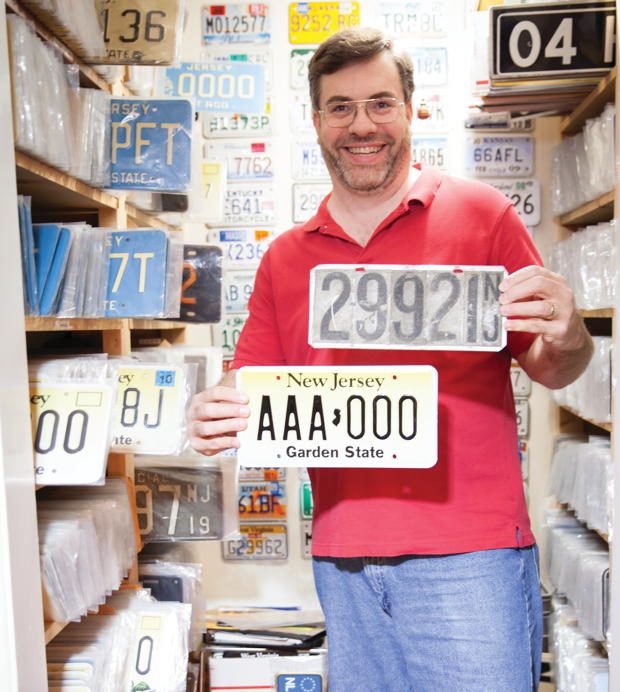
A cross-country car trip with his family in 1976 put Jim Moini on the road to his lifelong hobby.
“Sitting in the back seat, there was nothing to do but look out the window,” says Moini, who was eight at the time. “I noticed cars and out-of-state license plates with different colors and designs.”
Moini began keeping notes about plates; by the mid-1980s he began collecting them, starting with a plate from his parents’ 1963 Grand Prix (black letters on yellow background). Today, Moini, now 46, has about 4,000 plates, including 1,500 Jersey plates. In 1998, he launched a website—Moini.net—devoted to his pastime.
A computer programmer and software designer, Moini, a member of the Automobile License Plate Collectors Association, buys plates at swap meets, garage sales, car shows and via eBay. “In 1988, I went to an auto show in Englishtown and guys were selling license plates,” he recalls. “I came home with around $800 worth of plates that day.”
The most he’s paid for a single tag is about $200 for a 1906 Jersey plate. It’s difficult to put a dollar value on his collection. Like any collectible, he says, “it’s all in the eye of the beholder.”
Over the years, Moini, who is married with two sons, has seen his hobby evolve. Thanks to the Internet, he says, “it’s pretty easy to find plates.” A search for license plate on eBay can yield 100,000 results.
Moini displays some of his treasures in his Bergen County home, but most are stored in his basement. On his family’s three vehicles, Moini has two standard plates and one Discover NJ History special-interest plate.
Moini.net, which has photos of about 15,000 license plates, is a virtual museum, with plates from all 50 states plus the U.S. territories. The site also displays pictures of plates from Canada, including a bear-shaped plate from the Northwest Territories; Mexico; and apportioned plates used by truck drivers who travel through more than one state or Canadian province. Moini uses pictures from eBay and fellow collectors to illustrate plates not in his collection. The source is always properly credited, he says.
At the heart of the site are photos of Jersey plates dating to 1903, the first year they were required here. “License plates were started to make money,” Moini explains.
Until the state began issuing plates in 1908, early drivers had to create their own. “[Automobile] owners had to hire woodworkers, shoemakers or smithies to craft license plates with numbers assigned by the state,” according to a history on the New Jersey Motor Vehicle Commission website.
Moini.net traces the evolution of New Jersey plates. The words Garden State first appeared on the plates in June 1959; the outline of New Jersey showed up 20 years later. The familiar cream-yellow reflective background was adopted in 1992.
The newest change occurred last April, when the state replaced raised-letter plates with flat plates, supposedly because the letters are less likely to fade and peel. For Moini, nothing could be more exciting.
“They give me something new to look for on the road, keep track of, and eventually get for my collection,” he says. “I like them!”
Tom Wilk is a frequent contributor.



